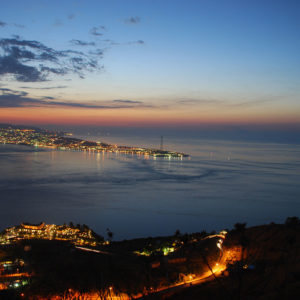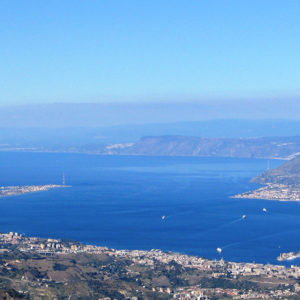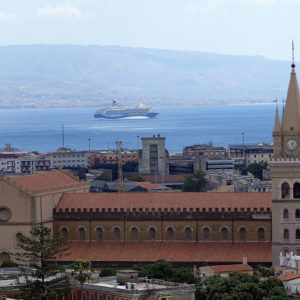Messina
The gate into Sicily and the connection to the mainland!
Messina is located on the Strait of Messina, connecting two seas: the Ionian in the east and the Tyrrhenian in the north. The Peloritani mountains stand as the backdrop of the town. This particular environment and this unique panorama make the present city well worth seeing.
Along with a city tour, one must include a detour to the viewpoint “Cristo Re” and a trip to the “Ganzirri” lakes in the northeast corner of Sicily. During the drive along the seafront, one can observe the strait and the Calabrian coast. This expansion of the trip allows one to discover old fishing traditions. The Ganzirri lakes are coastal lakes, separated from the sea by dunes but connected by a channel.
And now on to the actual town of Messina:
the third largest city in Sicily, Messina was already a popular trading post of the Cretan and Ionian sailors in the 2nd Millennium B.C. .
From this situation arose the Greek foundation of “Zancle” in the 8th century B.C., (‘zancle’ means sickle, and is named for the crescent-shaped peninsula that is surrounding the large natural harbor) and was renamed by immigrants from Messenien (Peloponnese) later in Messene .
In Roman times, Messina was known as the place where the first Punic war broke out. Beyond this, there is very little known from the Greek-Roman period. Likewise, hardly anything remains of the glorious Messina when it was the Metropolis of the whole Byzantine southern Italy.
During the Middle Ages when the Norman conquerors had replaced the Arab emirs in Palermo as rulers, Palermo formally remained capital, but Messina maintained its function as the most important harbour in connection with the eastern Mediterranean.
From this glorious period there are still many attractions found .
The cathedral, consecrated after about a century of construction by the German Emperor Henry VI was, in the 16th century, enriched by the cathedral master architect Angelo Montorsoli with many works of art.
Damaged by the infamous earthquake of 1908 and almost destroyed by Allied bombs in 1943, it has been rebuilt using American money, and could almost be described as a new building. Nonetheless, it still conveys the splendor of the Middle Ages in a suggestive way. Also worth seeing is the treasury with the famous golden mantle of the Madonna (Holy Virgin).
There are also two magnificent Renaissance fountains by Angelo Montorsoli: the Neptune fountain near the harbor with the sculptures of Scylla and Charybdis, and the Orion fountain in the cathedral square, called the most beautiful Renaissance fountain in Italy by the famous art critic Bernard Berenson.
A former Roman circular temple was transformed into the S. Maria Annunziata dei Catalani church, the private church of the Catalan merchants. It survived the 1908 earthquake and now is considered largely to be an architectural landmark.
Another point of interest is the bronze statue of John of Austria, who returned victorious over the Turks from the sea battle of Lepanto in 1571. He was the son of Charles V and had departed with the Christian fleet from the harbor of Messina.
A visit to Piazza Cairoli, considered the business center of Messina, would be a perfect way to conclude your tour.






